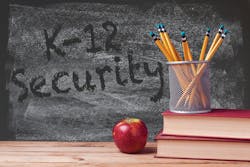This article originally appeared in the June 2020 issue of Security Business magazine. When sharing, don’t forget to mention @SecBusinessMag on Twitter and Security Business magazine on LinkedIn.
The K-12 school market provides a tremendous opportunity for security integrators. In order for integrators to succeed, they must understand the specific needs of each campus and be prepared to offer sensible and cost-effective solutions that truly protect the children and staff.
Campus security is continuously evolving as the challenges facing K-12 schools change and technology becomes more effective and affordable. Video surveillance is a good example – 20 years ago, most K-12 campuses in the United States lacked any cameras; today, video technology is ubiquitous with few schools lacking them.
As security integrators, we are now seeing the beginning of a new surge in electronic access control. Plastic credentials and card readers have been common on many colleges and university campuses for years; however, K-12 schools have stayed away primarily due to cost.
The need for administrators to immediately lock down all exterior and interior doors during an emergency are forcing them to give access control another look. In addition, teachers are asking for more control over who enters their classrooms.
Access Control in Today’s K-12 Facilities
Today’s access control systems eliminate many of the weak spots in traditional mechanical lock and key systems. Keys can be easily lost, stolen, lent or copied, which leads to rekey one or possibly all locks when it happens. That is expensive. Lost or stolen cards, on the other hand, can be deleted from a system in seconds.
Key-based systems also provide no audit trail capability, and the task of managing who possesses hundreds of campus keys is a logistical nightmare.
What is surprising are growing campus requests for mobile credentials. While it is a proven technology that has been used for more than a decade by the real estate and hospitality industries, it is just coming to the forefront in the K-12 environment, which is surely an opportunity for security integrators.
Most often, smartphone-based access control systems enable administrators to lock down an entire campus wherever they are with the push of an app button; however, smartphone-based credentials can also balance convenience and security. The mobile credentials add an extra layer of campus security, as they require possession of the phones and a biometric or PIN. Lending a credential to another employee less likely as smartphones are loaded with personal data.
Substitute teachers can be emailed a credential and app the night before an assignment, allowing the person to proceed directly to the classroom without having to stop at the front office for a credential.
Biometric readers are becoming increasingly popular on many higher education campuses for access to dormitories, recreation centers and making food purchases; however, it is rare to see them installed at the K-12 level. Many administrators say they would like the added security offered by biometrics but balk at the price of readers – which can be 10 times the cost of traditional access readers.
Video Surveillance Evolves in K-12
On the video side, we are installing many more multi-sensor cameras with four imagers in a single dome. Similar cameras have been available for years, but until recently, the imagers could not be separately adjusted. Now, that is possible – making these panoramic cameras a highly effective security tool.
The cameras are ideal for K-12 parking lots, building perimeters and intersecting hallways, and they come at less than the cost of four separate devices. A single dome also saves one-time license fees plus annual support for software and network switch ports. An even more significant savings comes from the need to pull a single wire – instead of four – to connect the dome.
As cameras continue to add resolution – we have seen and installed 4K and even 8K cameras on K-12 campuses – it is essential to consider compression standards. The latest H.265 standard is not yet widely used due to VMS manufacturers playing catch up; however, an integrator’s job is to future-proof an end-user’s investment by installing H.265-compliant cameras – even though we still set them at H.264 to work with the VMS.
In comparison to its predecessor, H.265 standard offers up to 50% better data compression at the same level of video quality.
Video monitoring systems are helping campuses collect and manage video. A student resource officer may oversee monitoring, but the task often falls to an assistant principal. A few larger districts have security operations centers with staff to monitor input from multiple campuses.
Sensors, Alarms and Visitor Management
What else is new at K-12 schools? Vapor detectors have become popular on middle and high school campuses. These sensor devices, which resemble a smoke or carbon monoxide detector, detect vaping in bathrooms or closets – places where students have smoked for decades. Some units can be equipped to detect THC oil, a compound found in marijuana.
Specialized sensors may also detect sound abnormalities like shouting, which could help prevent bullying. Once activated, the sensors are integrated to push video from cameras mounted outside the restrooms to show who leaves. Students may have already left the area if an administrator had to search for the right camera.
Wireless panic buttons are also becoming more popular; in fact, many states are considering making them a requirement, and New Jersey and Florida have already done so. The legislation –known as Alyssa’s Law in honor of one of 17 people killed in 2018 when a gunman attacked Marjory Stoneman Douglas High in Parkland, Fla. – requires panic buttons in K-12 classrooms, libraries, cafeterias, offices, parking lots and on playgrounds to connect teachers and administrators directly to district security or local first responders. Some districts also augment or replace mounted buttons with wearable pendants.
Video intercoms remain widely popular as a means of controlling visitors at main entries, but this market has been heavily saturated. Two-way audio intercoms with call buttons are ideal for linking classrooms and the main office. Visitor management systems use a visitor’s government-issued ID to check for national, state and in-house logs for registered sex offenders, other criminals and parents involved in custody disputes.
How Integrators can Prosper in the K-12 Vertical
Beyond the technology options, K-12 campuses offer several excellent opportunities for integrators to create recurring revenue and become a trusted advisor to individual facilities and districts.
First, because school budgets are notoriously tight, it is important to closely follow the plans for new campus buildings and successful bond issue elections at a state level. Security typically plays a significant role in the plans for new school construction.
Once you know they money will be allocated, here are ways for integrators to create RMR in the K-12 market:
Service and maintenance agreements, including preventive maintenance such as checking batteries and locking and cleaning cameras, as well as reactive services such as responding to a door reader that has stopped working.
Operational services – Often a school’s HR staff would be happy to let an integrator have control of changing the holiday schedules for the access control system and credential maintenance for new hires and terminations.
Video monitoring and alarm verification – School administrators can be easily overwhelmed with the tremendous amount of video collected, so they are likely to be receptive to outsourcing monitoring and alarm verification services. Integrators who can provide these services also create a competitive edge.
Integrator-managed and/or hosted systems – Despite clear benefits, K-12 schools have been slow to move to hosted/managed access control and video systems. Try starting with one system on a single campus and let administrators see the advantages.
Training – Integrators should help K-12 customers prepare for emergencies with written security policies and procedures. Additionally, the quantity of security equipment on a campus – video, access, intrusion alarms, intercoms, panic buttons, and more – can be overwhelming. Administrators and staff will need training to use the equipment properly, as well as advice in the best way to conduct lockdowns, evacuations and regular drills.
Risk assessments – Use summer breaks (or COVID-19 shutdowns) when many campuses are empty to conduct a free risk assessment.
Angie Wong is president and CEO of Fremont, Calif.-based security integrator Ojo Technology.



